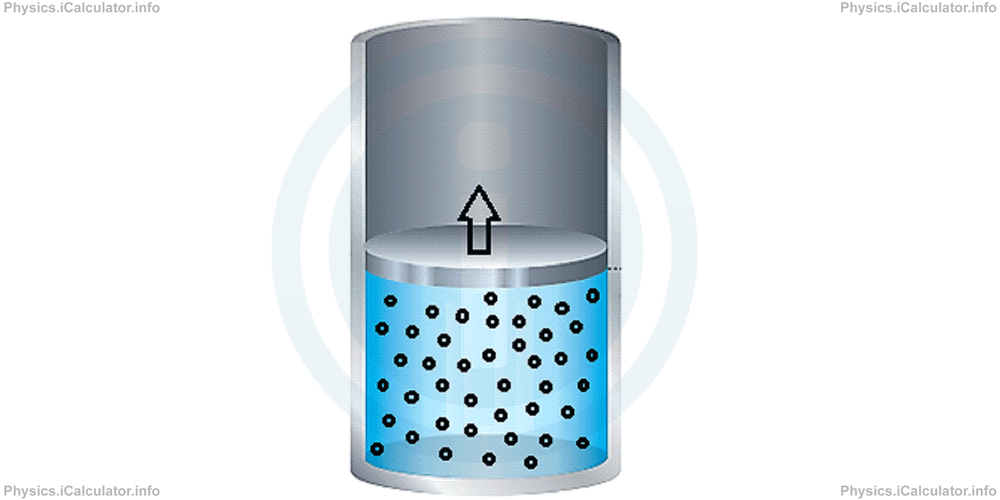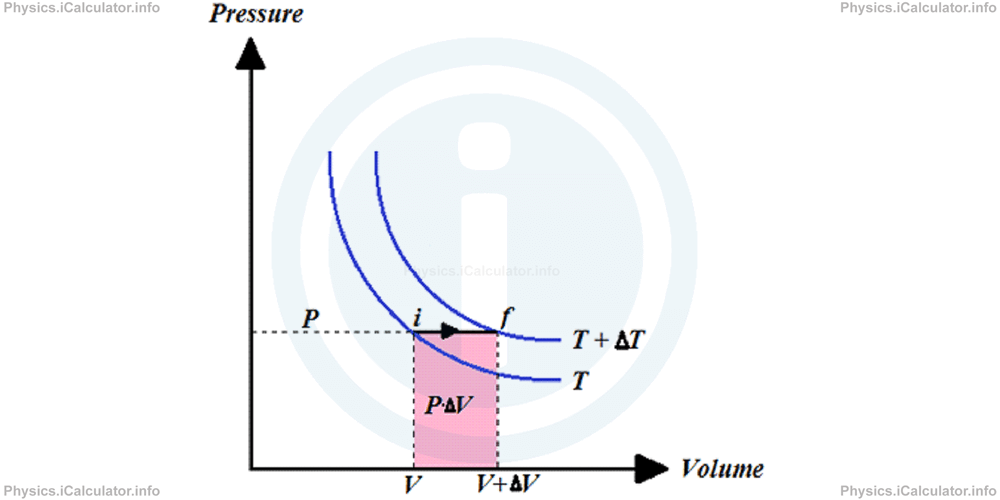Menu
Physics Lesson 13.8.3 - Molar Specific Heat at Constant Pressure
Please provide a rating, it takes seconds and helps us to keep this resource free for all to use
Welcome to our Physics lesson on Molar Specific Heat at Constant Pressure, this is the third lesson of our suite of physics lessons covering the topic of Molar Specific Heats and Degrees of Freedom, you can find links to the other lessons within this tutorial and access additional physics learning resources below this lesson.
Molar Specific Heat at Constant Pressure
Now, let's assume the container which holds the ideal gas is not fixed, i.e. its piston can slide freely up and down.

If we supply some heat to the gas enough to increase its temperature from T to T + ΔT like in the previous paragraph, the piston will move up as the gas expands due to the increase in temperature but the pressure remains constant. In both cases, the inner pressure of gas balances the effect of atmospheric pressure plus the pressure exerted by the piston's weight).
Similarly as in the process with constant volume, we have for the heat absorbed by the ideal gas at constant pressure
where Cp is known as the molar specific heat at constant pressure.
The value of Cp is numerically greater than the corresponding value of CV for the same change in temperature as in the process with constant volume, a part of heat energy supplied goes for doing work for lifting the piston.
Given that the temperature increases without any change in pressure, we obtain for the P - V graph:

Let's find the relationship between the two molar specific heats CV and Cp.
From the First Law of Thermodynamics, we know that
Given that at constant pressure the work done by the gas to lift the piston is
we obtain
= n × Cp × ∆T - n × R × ∆T
Also, given that
we obtain
Dividing both sides by n × ΔT, we obtain
Or
For a monoatomic gas, we have
= 5/2 R
≈ 20.8 J/mol × K
Therefore, we can write for the heat absorbed by a gas at constant pressure to increase its temperature by ΔT:
This value is greater than the corresponding value of heat energy during a process at constant volume for the same increase in temperature (Q = 3/2 n R T), as we predicted earlier.
Example 2
What is the heat energy required to increase by 50 K the temperature of 2 moles of an ideal monoatomic gas at constant pressure?
Solution 2
Clues:
ΔT = 50 K
n = 2
ΔQ = ?
Using the equation for heat absorbed by an ideal gas at constant pressure, we can write:
= 5/2 × 2 moles × 8.31 J/mol × K × 50 K
= 2077.5 J
You have reached the end of Physics lesson 13.8.3 Molar Specific Heat at Constant Pressure. There are 4 lessons in this physics tutorial covering Molar Specific Heats and Degrees of Freedom, you can access all the lessons from this tutorial below.
More Molar Specific Heats and Degrees of Freedom Lessons and Learning Resources
Whats next?
Enjoy the "Molar Specific Heat at Constant Pressure" physics lesson? People who liked the "Molar Specific Heats and Degrees of Freedom lesson found the following resources useful:
- Pressure Feedback. Helps other - Leave a rating for this pressure (see below)
- Thermodynamics Physics tutorial: Molar Specific Heats and Degrees of Freedom. Read the Molar Specific Heats and Degrees of Freedom physics tutorial and build your physics knowledge of Thermodynamics
- Thermodynamics Revision Notes: Molar Specific Heats and Degrees of Freedom. Print the notes so you can revise the key points covered in the physics tutorial for Molar Specific Heats and Degrees of Freedom
- Thermodynamics Practice Questions: Molar Specific Heats and Degrees of Freedom. Test and improve your knowledge of Molar Specific Heats and Degrees of Freedom with example questins and answers
- Check your calculations for Thermodynamics questions with our excellent Thermodynamics calculators which contain full equations and calculations clearly displayed line by line. See the Thermodynamics Calculators by iCalculator™ below.
- Continuing learning thermodynamics - read our next physics tutorial: Gas Laws
Help others Learning Physics just like you
Please provide a rating, it takes seconds and helps us to keep this resource free for all to use
We hope you found this Physics lesson "Molar Specific Heats and Degrees of Freedom" useful. If you did it would be great if you could spare the time to rate this physics lesson (simply click on the number of stars that match your assessment of this physics learning aide) and/or share on social media, this helps us identify popular tutorials and calculators and expand our free learning resources to support our users around the world have free access to expand their knowledge of physics and other disciplines.
Thermodynamics Calculators by iCalculator™
- Carnot Engine Efficiency Calculator
- Entropy Calculator
- Gas Laws Calculator
- Molecular Mean Free Path Calculator
- Translational Kinetic Energy Of Gas Calculator
- Root Mean Square Speed Calculator
- Ideal Gas Law Calculator
- Change In The Gas Internal Energy Calculator
- Radiative Heat Transfer Calculator
- Evaporative Heat Transfer Calculator
- Convective Heat Transfer Calculator
- Conductive Heat Transfer Calculator
- Final Temperature Of Mixture Calculator
- Heat Absorbed Or Released Calculator
- Thermal Expansion Calculator
- Temperature Calculator